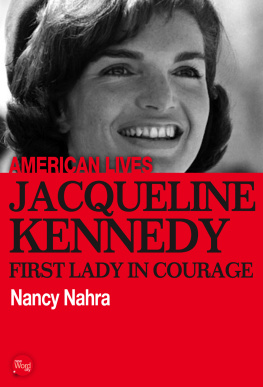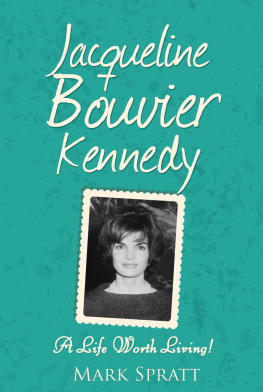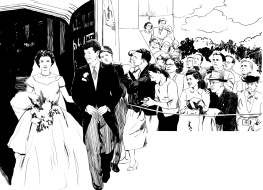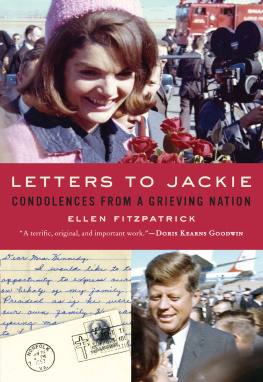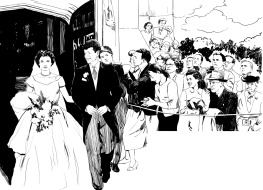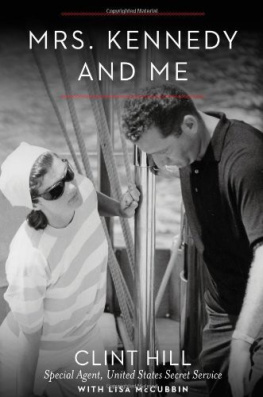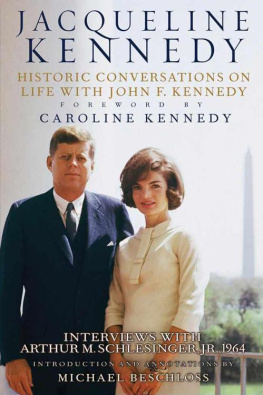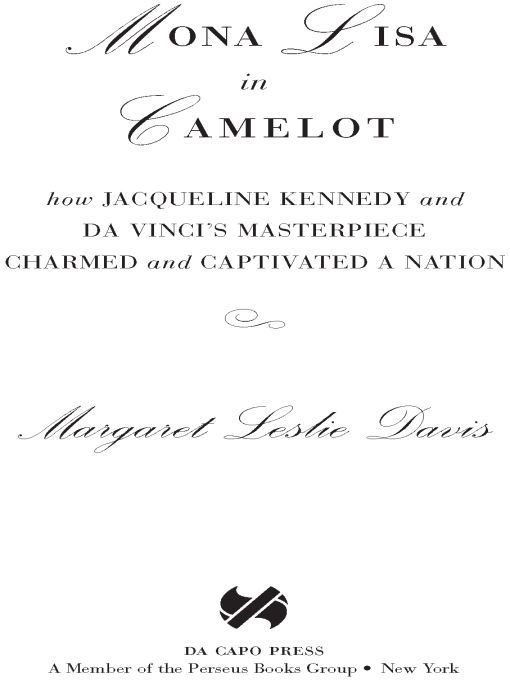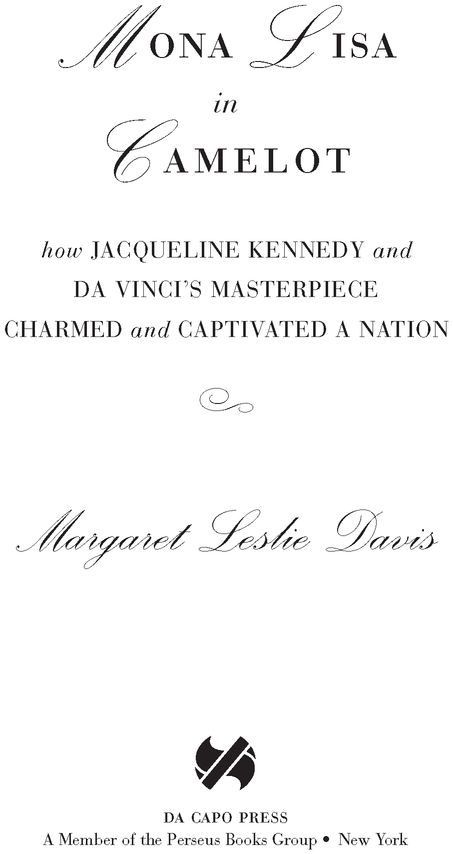Table of Contents
For the Womens Literary Society
AUTHORS NOTE
I started this book with the intention of writing a history of the triumphant American exhibition of Leonardo da Vincis Mona Lisa. Early into my research, however, I discovered a surprise: First Lady Jacqueline Kennedy had been the mastermind behind the 1963 exhibition, which was made possible only through her alliance with National Gallery Director John Walker and her adept international diplomacy.
Sent as a personal loan to the President and Mrs. Kennedy by the French government, the famous painting arrived in the States on December 19, 1962, where it was exhibited in Washington, D.C., and New York for fifty-two days. Nearly two million Americans, for many their first visit to an art museum, stood in long lines for a chance to see a masterpiece created in the early sixteenth century. As if engaged in a religious pilgrimage, visitors traveled great distances and waited for hours, ready to embrace the Mona Lisa, a harbinger of a transcendent new era.
The visit of the Mona Lisa produced the greatest outpouring of appreciation for a single work of art in American history and pioneered the phenomenon of the blockbuster museum show. It was one of the most daring, elaborate art exhibitions ever staged, and the paintings unlikely, romantic journey to America captured the imagination of the world.
What follows is a true story. The principal events take place over the course of two years beginning in March 1961 and ending in the spring of 1963. Jacqueline Kennedy mustered the full force of her influence as First Lady to bring the Mona Lisa to America, all the while drawing on her innate understanding of symbols and image crafting to infuse the exhibition with a sense of history, drama, and pageantry. The Mona Lisas controversial visit also served vital national interests at a decisive moment in U.S. history, and La Joconde, as the painting is known in France, was transformed into an icon of freedom at the height of the Cold War.
The paintings successful debut awakened a passion for culture that had been dormant in the national psyche during the provincial postwar years, and the sensational exhibit ignited a national love affair with the arts. In his emotional speech at the closing ceremony at the Metropolitan Museum of Art, John Walker acknowledged that the great achievement of the exhibit was not how many people came to see the Mona Lisa, but rather that the painting acted as a catalyst. Her visit, he said, stirred some impulse toward beauty in human beings who may never have felt that impulse before.
PART ONE
THE ART ENTHUSIASTS
Jacqueline Kennedy looked closely at the eight paintings by Paul Czanne displayed for her on easels arranged in a wide row. At her side was National Gallery Director John Walker, standing with his arms crossed, beaming like a proud father. He nodded knowingly as he watched her select the most exquisite of them all: The Forest and House on the Marne.
The new First Lady had learned that a group of magnificent Czannes had been bequeathed to the White House but for unknown reasons had ended up at the National Gallery. Not long after the inauguration she telephoned Walker and asked to see them. Walker wasnt surprised to hear her lay claim to the Czannes. After all, he had known Jackie since she was a child.
The extended families of Jacqueline Bouvier and John Walker had moved for generations in the same wealthy, socially connected circles of New York City, East Hampton, Newport, and the sprawling estates of Virginia. Walker was a lifelong friend of Hugh D. Auchincloss, Jackies stepfather, and Walker often visited Merrywood, the Auchincloss estate. The forty-six-acre wooded retreat overlooking the Potomac River in McLean, Virginia, had been Jackies home since 1942. Although she was a sophisticated urbanite who enjoyed elite company in the worlds great cities, she often returned to the countryside and seashore.
I always love it so at Merrywoodso peacefulwith the river and the dogsand listening to the Victrola, Jackie once told her stepbrother, Hugh D. Auchincloss III. I will never know which I love bestHammersmith [Farm] with its green fields and summer windsor Merrywood in the snowwith the river and those great steep hills.
It was only natural that when Jackies mother, Janet Lee, took her teenage daughters to Washington, D.C., for cultural enrichment, they would call on John Walker for a personal tour of the National Gallery. Walker noticed that Jackies interest in art was more than casual for a girl her age; she was drawn particularly to the works of the great French impressionists, including pictures by Renoir and Monet. Walker understood why the vivid landscapes would appeal to a quiet, studious youngster who had grown up loving the outdoors.
In a handwritten thank-you note following one guided tour, Walker detected more than proper etiquette from young Jacqueline. He saw a real interest in art and a surprisingly heartfelt resolution. Im still floating on air after my idyllic afternoon at the Gallerythose few hours made it worth staying in Washington for the entire summer, Jackie wrote Walker. I came away in an absolute frenzy of excitement, and resolved (oh please let me keep the resolutions this time) to go back nearly every dayand read and readand write things about the paintings I love.
The earnest adolescent who had once strolled about the National Gallery with such joy was now the First Lady and had summoned Walker to assemble the Czannes for herpaintings that he knew she would love.
As head of the National Gallery, Walker had a proprietary interest in the Czannes. Not only did they provide him pleasure because of their superb quality and place in art history, but he had also personally taken a hand in seeing to it that they came to the Gallery. In fact, hed assured their arrival by a ruse that he later admitted was somewhat ignoble for a museum curator, but he felt it was urgent that the paintings come into his care as soon as possible.
Had it been anyone but Jackie Kennedy who wanted them, he would have barred the door to their departure. Instead, he arranged a private viewing at the Gallery, where he displayed the eight master paintings so Jackie could pick the two she liked best.
Her selection was not dictated solely by her instinct as a connoisseur, but came as well from an emotional connection with the outdoor scenes Czanne had created. The Forest was painted with summer colors of blues, greens, and yellows, layered against the strong dark hues of branches and trunks of trees lining a path that invited the viewer deep into the painting. House on the Marne was also a statement of vibrant color, with strokes of alizarin crimson, burnt sienna, and traces of yellow offering a glimpse of a cottage along a riverbank. The rich colors were repeated in the reflections of the smooth, glassy water.
Walker was pleased, but not surprised by Jackies strong eye. She had been educated at the best private girls preparatory schools, where exposure to the cultural arts was encouraged. As a Vassar College student, she had continued a similar curriculum that had been bolstered with extensive travel, in which she spent her junior year studying at the Sorbonne in Paris, a life-changing experience that had shaped her adult tastes.
When she returned from Europe, she was no longer the round little girl who lived next door, an old friend said. She was more exotic. She had become gayer and livelier. Blanching at the prospect of returning to Poughkeepsie, New York, to be a little girl at Vassar again, Jackie chose instead to live with her mother and stepfather at Merrywood so she could complete her college degree in the nations capital at George Washington University.



